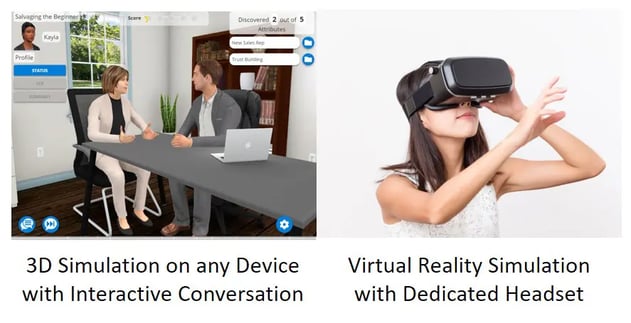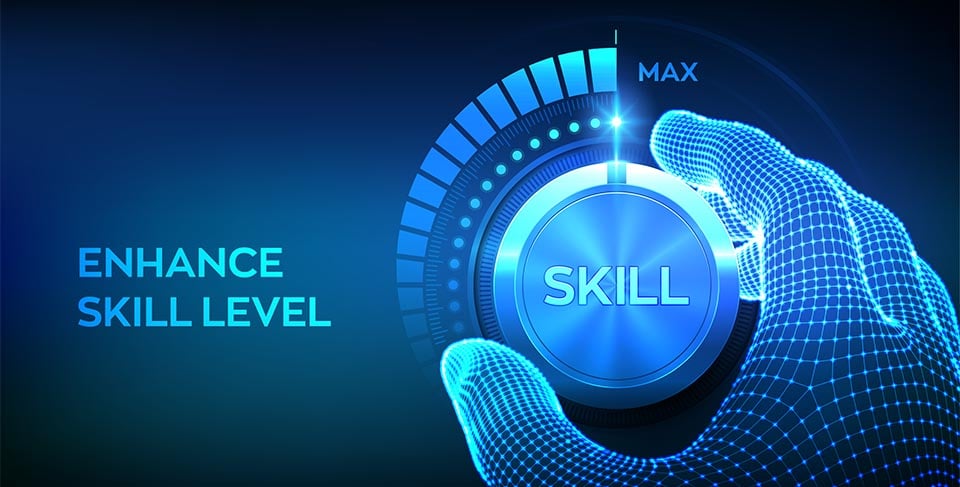
This article was originally published in Life Science Trainers & Educators Network’s (LTEN) Focus Magazine.
Pulling training concepts through to the workplace is a challenge, particularly in leadership, coaching, and sales. Why? Because workers may “know” the concepts taught but lack the skill and the confidence to use them, once they’re back on the job. So, nothing changes.
Developing skills, particularly these soft skills, requires a different approach. Trainees don’t want to risk failure by trying something new in real situations. That’s where practice comes in. Roles plays at the end of a training session are a start, but they’re not comprehensive enough, nor do they provide the reinforcement weeks after training to drive behavior changes.
Solving the “Not Enough Practice” Problem
The solution involves two parts:
- Utilize effective skill-development learning methodologies to create behavior change.
- Use simulation technologies to provide a scalable, measurable way to deliver “virtual practice”.
Let’s talk about each one.
Cognitive Apprenticeship: A Skill Building Learning Methodology
Cognitive apprenticeship is a powerful learning methodology that can be uniquely applied to soft skill acquisition. Just as its name implies, it’s like an apprenticeship for thinking skills. Essentially it involves placing learners in realistic situations where they practice making decisions. They receive mentoring feedback (coaching) on each decision, which rapidly accelerates skill acquisition.
How does this work? As the learner receives coaching on decisions, they begin to recognize the “expert” mental models their mentor is using to make optimal choices. As the learner incorporates these patterns into their own mental model, they begin to respond optimally in real situations, with confidence.
It’s no coincidence that this learning methodology may describe interactions with your best mentor or coach. We know it works. But it requires specialized, expensive human capital in order to scale. That’s where virtual practice technology comes in as the second part of the solution.
How to Incorporate Virtual Practice Technology in 5 Steps
Step 1: Admit you have a problem. If you’re training on processes in leadership, coaching, or sales and you’re not seeing the desired results, ask if your organization is giving trainees enough quality practice time. If not, then doing so can make these training investments far more effective.
Step 2: Prioritize your performance gaps. Identify desired behaviors (rooted in your new processes and best practices), as well as the behaviors you’re currently observing. Then prioritize these performance gaps for their impact on your organization. This list will become the scope for your practice scenarios.
Step 3: Evaluate simulation technology options. Research studies in medicine, military, and other high performing fields, show that the more realistic the simulation, the more effective it is at improving performance. For soft skills, it’s all about conversation, so the ideal technology implementation should have interactive conversation, with decision making and feedback.
Technology Options
- 2D Simulations are created in LMS authoring tools like Articulate, Captivate, iSpring, etc. These simulations are not very immersive, and rely on text, images, video, and some voiceover capability.
- 3D Simulations immerse the learner in 3D environments with virtual characters. Ideally, there’s more than one character to participate in virtual conversations. The characters should talk, to provide realistic examples of what to do, and not to do, along with conversational coaching. Solutions include proprietary experiences built for a specific methodology (such as in sales), and platforms that allow custom development of scenarios based on customer needs.
- Virtual Reality (VR) solutions are like 3D simulations, only they involve added hardware (the headset). Because most soft skill situations focus on conversations, not the physical environment, the added cost of VR immersion may not be appropriate. However, if the goal is for learners to understand empathy, then the added cost of VR immersion can be justified.

Step 4: Develop and Deliver Realistic Simulated Scenarios with Real-world Decisions. Now it’s time to build your scenarios within the chosen technology solution. Most importantly, a simulation should not become a passive video that just shows the learner what to do. Instead, a simulation should allow learners to self-discover optimal decision making as they make decisions and receive coaching feedback.
Step 5: Measure the Results. Your trainees will be making virtual decisions in your critical performance areas. This data provides valuable insights! Ask vendors to describe the analytics they will provide. Be aware that getting these analytics from branching 2D simulations is difficult, and custom solutions may not have analytics at all. Platform solutions should provide integrated analytics mapped to your performance gaps.
Final Thoughts
Simulation technologies provide a scalable way to deliver consistent virtual practice experiences across your organization, and in the best of them, measure the results. Hopefully, these five steps provide a framework that will get you started toward changing the behaviors of your professionals through virtual practice.
About Syandus: Virtual immersive learning technology that transforms knowledge into real-world performance. We immerse participants in realistic virtual situations with one-on-one expert coaching that gives them experience making optimal decisions. Syandus Learning Modules combine cognitive science principles, the realism of game technology, and our customer’s proprietary content, to deliver rapid skill acquisition. Modules are cloud-based for easy deployment, fully trackable with embedded analytics, and can be used on any web-enabled device.



